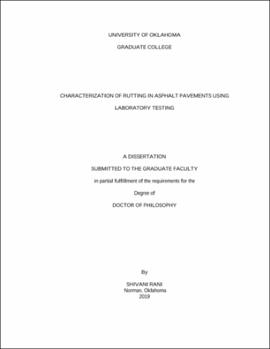| dc.description.abstract | In asphalt pavements, rutting is one of the main concerns at high in-service temperature, which can occur either through plastic flow or shear in structural layers. Rutting depends on several factors, such as asphalt binder grade, binder content, aggregate gradation, air voids, traffic loading, and temperature. Base and sub-base layers and subgrade soil conditions also influence rutting. Excessive rutting can result in structural failure, loss of control while driving, and hydroplaning in the presence of water. The present study aims to evaluate the rutting potential of asphalt mixes using laboratory testing.
For this purpose, 49 different binder blends were prepared by mixing asphalt binders (PG 58-28, PG 64-22, PG 70-28, and PG 76-28) with different amounts of Polyphosphoric Acid (PPA - 0%, 0.5%, 1.0%, 1.5%, and 2.0%), Warm-Mix Asphalt (WMA) additive (0% and 0.5%), and Anti-Stripping Agent (ASA - 0% and 0.5%). Laboratory tests, namely Dynamic Shear Rheometer (DSR), Multiple Stress Creep and Recovery (MSCR), Bending Beam Rheometer (BBR), and Rotational Viscometer (RV) were conducted on the binder blends at different temperatures and aging conditions. It was found that PPA enhanced the rutting resistance of the tested asphalt binders without adversely affecting their low-temperature cracking resistance. Adding 1.0% or a higher amount of PPA bumped the Superpave® high-temperature PG by one grade. The binder blends containing 1.5 to 2.0% PPA were found to sustain an extreme level of traffic loading without undergoing significant deformation. Additionally, the effectiveness of PPA in a binder was found to reduce due to the addition of ASA and WMA additive. Based on these results, it was concluded that using 0.5% ASA or 0.5% WMA additive can neutralize the effect of 1.0 to 1.5% PPA.
Also, four different asphalt mixes produced using binder blends containing a PG 64-22 binder, 1.5% PPA, 0.5% WMA additive, and 0.5% ASA were prepared in the laboratory and tested using a Hamburg Wheel Tracking (HWT) device to evaluate their rutting and moisture-induced damage potentials. It was found that, the tested mixes had low rutting and moisture-induced damage potentials. However, the Tensile Strength Ratio (TSR) results revealed the possibility of moisture-induced damage in some cases, which was not supported by the HWT test results. | en_US |
